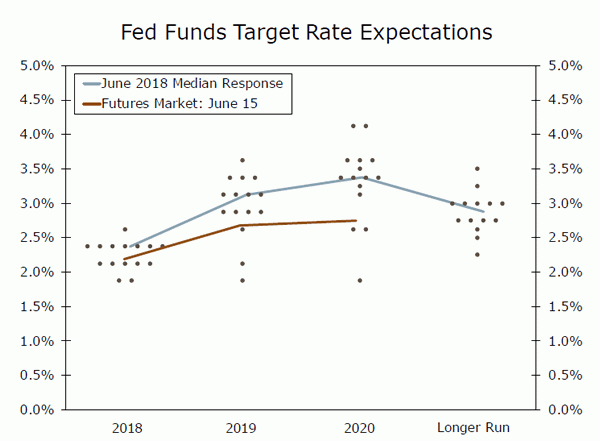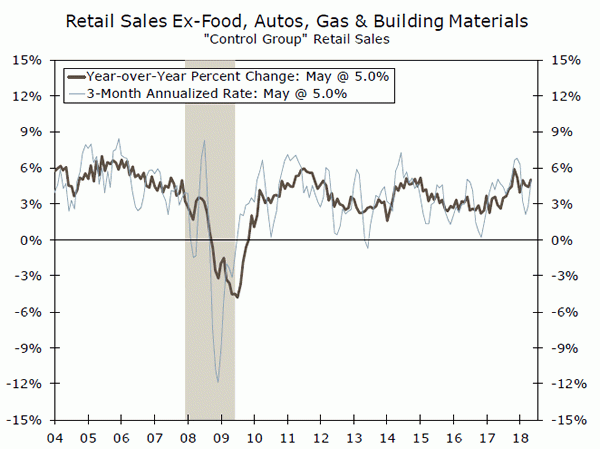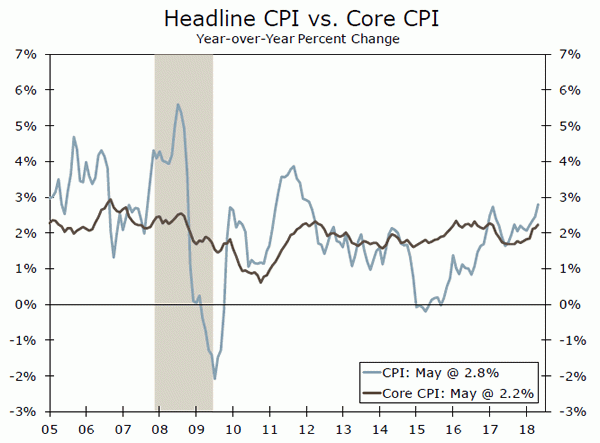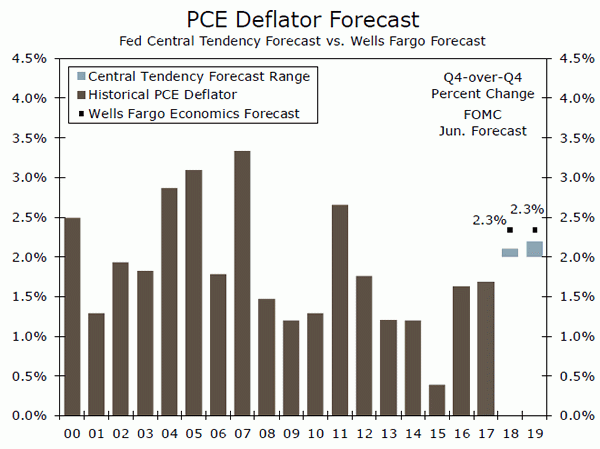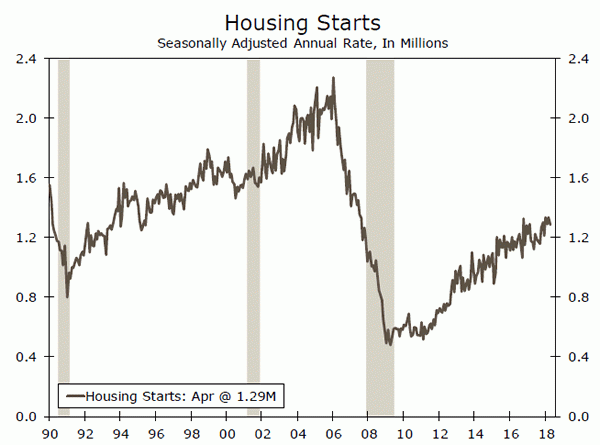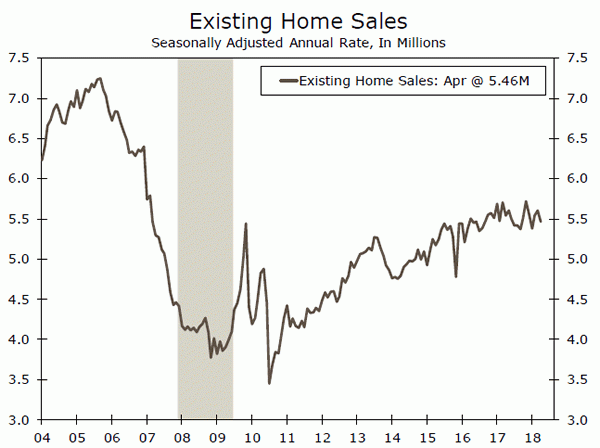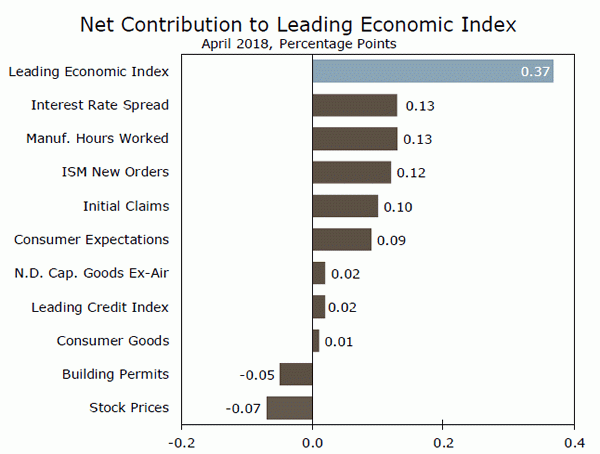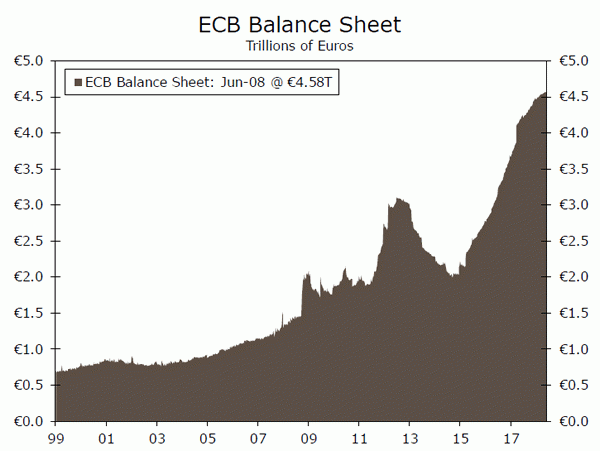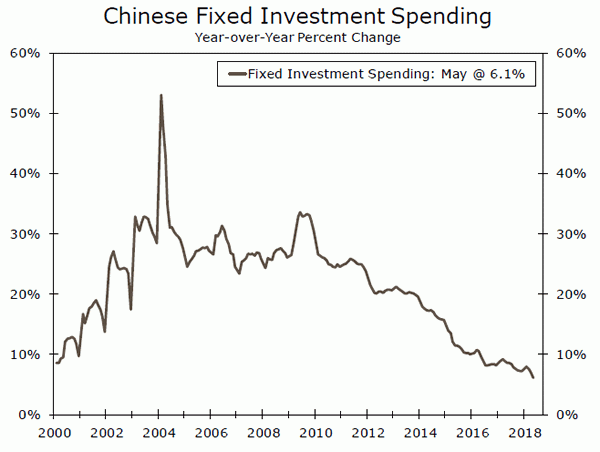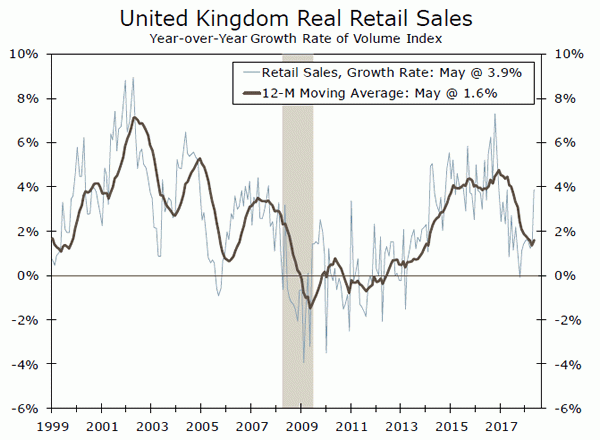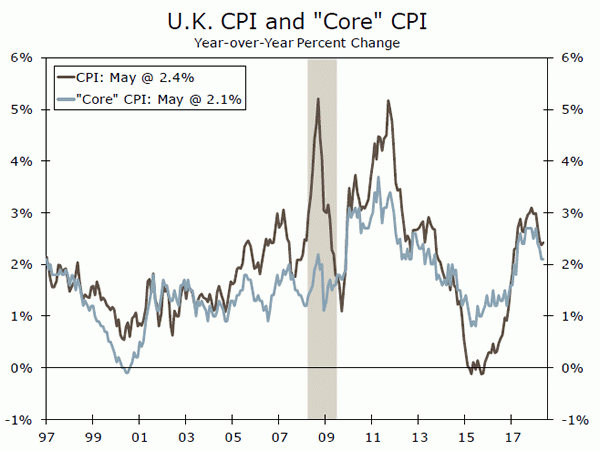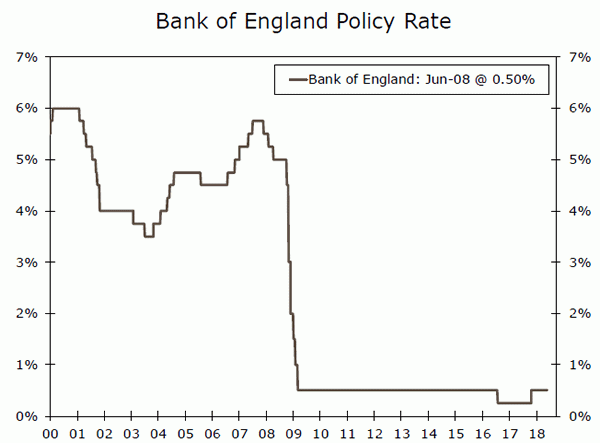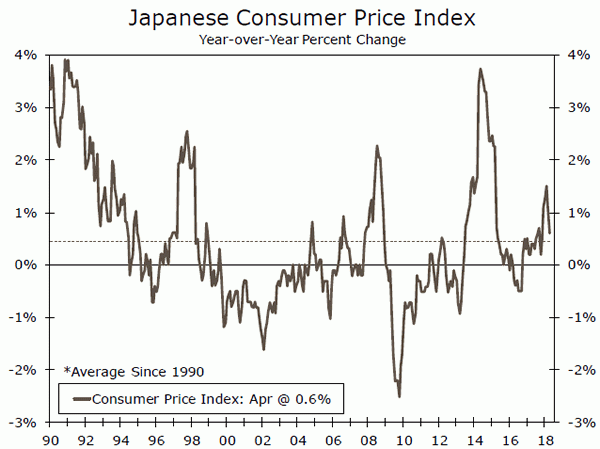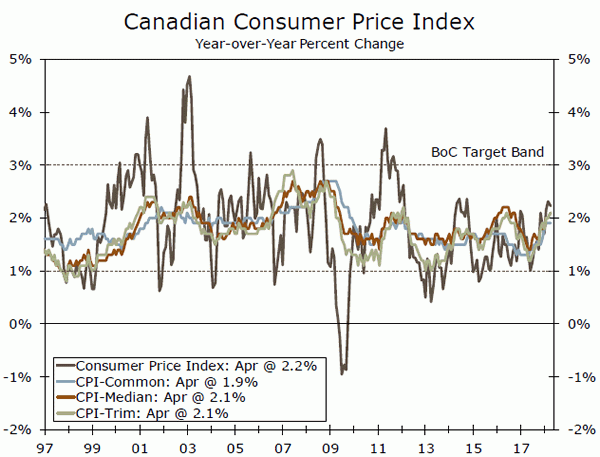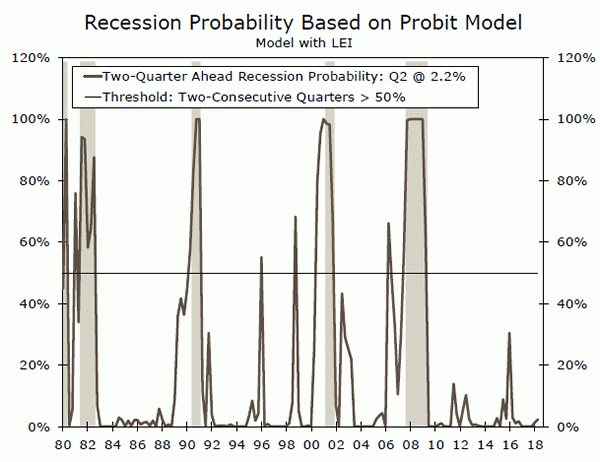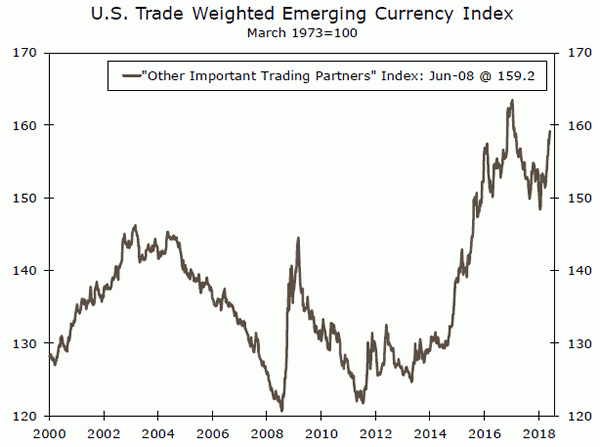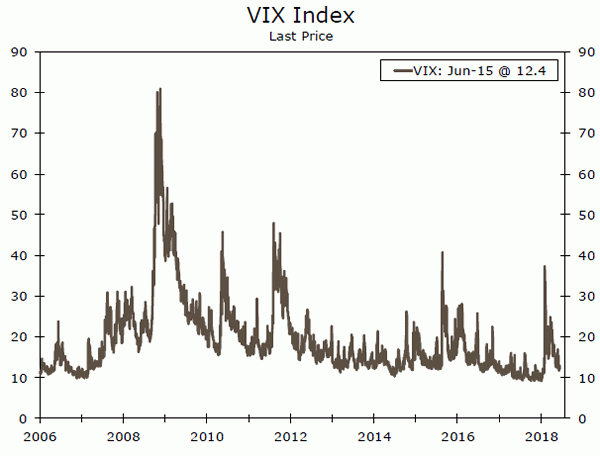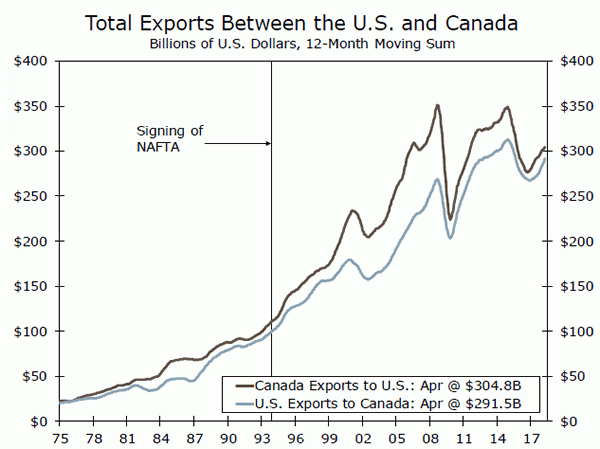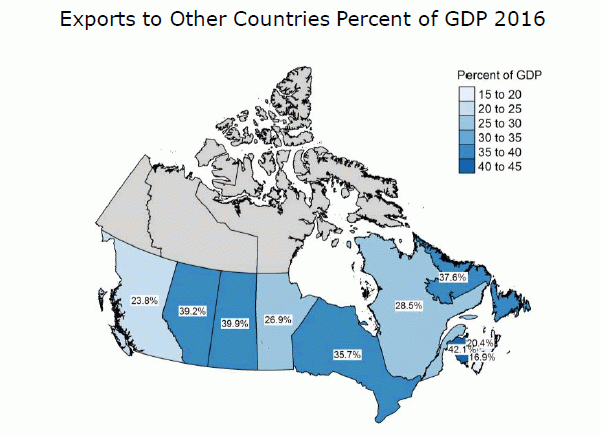U.S. Review
FOMC Signals Four Rate Hikes for 2018
- The FOMC raised the target federal funds range 25 bps to 1.75-2.00 percent and projected a fourth rate hike this year, while also upgrading its outlook for GDP and inflation.
- The American consumer flexed its muscle in May, as evidenced by robust retail sales. We should see a fairly pronounced rebound in overall consumption in the second quarter GDP print.
- Inflation-related indicators strengthened in May. Core CPI is running at 2.2 percent–roughly consistent with the Fed’s target.
September and December
While the FOMC meeting dominated the market headlines this week, several closely watched indicators surprised to the upside, indicating continued strength in the economy. However, perhaps the most surprising economic release this week was the strength seen in the May retail sales report. Headline sales surged 0.8 percent following an upwardly revised 0.4 percent in April. Much of the recent strength in retail sales has been attributed to rising gasoline prices. However, excluding gasoline station sales, sales increased an impressive 0.7 percent. Moreover, the relatively strong print in automobile sales is, perhaps, the realization by American consumers that higher interest rates are an increasingly likely reality and that they should move ahead of higher future interest rates. After a disappointing performance for the U.S. consumer in the first quarter, spending strength has returned in Q2. This is further evidenced by the renewed strength in control group sales, which surprised to the upside again (top graph).
While the strength in retail sales certainly did not go unnoticed, it was overshadowed by the FOMC’s June meeting. As markets widely expected, the Fed raised the target federal funds range 25 bps to 1.75-2.00 percent and added a fourth rate hike into its projections for 2018. This implies that it expects to raise the funds rate at the September and December meetings. The more hawkish stance can likely be attributed to the continued tightening we are seeing the labor market. The decline in the unemployment rate below 4 percent signals future upward pressure on inflation, therefore supporting continued fed funds rate increases. However, in the current economic expansion, the decline in the unemployment rate has not been matched by an anticipated increase in measured inflation, that is, until very recently.
Prior to the FOMC’s policy meeting on Tuesday, CPI inflation was reported for April and was largely in-line with expectations (middle graph). Consumer price inflation continues to gradually pick up, which adds further support to the Fed’s plan to hike rates at its September and December meetings. Higher core inflation continues to be driven by the service sector, and is rising at the fastest pace since January 2017. Likewise, producer price inflation (PPI) continues its upward momentum. As pipeline pressures have picked up in May, input costs for processed and unprocessed goods as well as services have increased more than 3 percent over the past year and suggest further upward pressure on final selling prices in the months to come. Moreover, import prices jumped 0.6 percent in May on the back of higher fuel costs. The unemploymentinflation relationship, which until recently seemed broken, appears to be warming again.
For the FOMC, the way ahead for the funds rate is clear, with steady rate increases through 2020. We remain skeptical of such a smooth plan given the Fed’s concurrent operation to shrink its balance sheet. Additionally, we are beginning to see credit strains in mid-to-lower-credit households, such as rising delinquency rates in autos and credit cards, which have the potential to be the wrench in the Fed’s machine.
U.S. Outlook
Housing Starts • Tuesday
Housing starts slipped 3.7 percent in April as multifamily building halted. Multifamily accounted for all of the drop, as single-family starts edged higher. Single-family starts through the first four months of the year are running 8.3 percent ahead of last year, which shows the housing market is on solid footing despite month-to-month swings. Some of the recent volatility can be traced to extreme weather in the Midwest and Northeast, as well as the topping out of apartment construction, as deliveries in many markets have pushed up vacancy rates. Demand for single-family housing continues to climb, with the strong labor market fueling income gains. Supply of existing homes is limited, making new single-family building more crucial. Continued optimism among the nation’s homebuilders suggests a solid spring home selling season despite disappointing headline readings in recent months.
Previous: 1.29M Wells Fargo: 1.30M Consensus: 1.32M (SAAR)
Existing Home Sales • Wednesday
Existing home sales slipped 2.5 percent in April to a 5.46-milllion unit annual pace, after rising the prior two months. The weakness was in single-family sales, which were down 3 percent on the month. Inventory constraints are clearly holding back the resales market and the associated economic activity sales provide.
Evidence that buyer demand is not the problem is that homes are selling quickly and at increasing prices. The typical home sold in April was on the market for only 26 days. Contributing to the competition between buyers for newly listed homes is the strong job market putting homeownership within reach for more Americans. Home prices are rising faster than income in many areas, however, challenging affordability. Borrowing costs are set to increase as the Fed normalizes policy, and higher mortgage rates are likely to exacerbate affordability challenges as borrowers pay a larger share of their incomes towards interest.
Previous: 5.46M Wells Fargo: 5.57M Consensus: 5.58M (SAAR)
Leading Index • Thursday
The Conference Board’s measure of leading economic indicators is signaling continued growth in the U.S. on broad-based strength. The Leading Economic Index increased 0.4 percent in April and, although the six-month growth rate has moderated, the uptrend in economic growth should continue through the second half of the year.
Building permits and stock prices were the only drag on the index in April and the interest rate spread remained the top contributor to growth. Its strength has waned somewhat, however, on the recent flattening in the yield curve. Labor market components added to April’s growth after exerting a drag in March. Initial claims will likely boost the leading index in May as claims hit an all-time low during the month. Still, the May print will likely continue pointing to well balanced, steady economic growth through 2018.
Previous: 0.4% Wells Fargo: 0.2% Consensus: 0.4% (Month-over-Month)
Global Review
Eventful Week for Foreign Economic Developments
- At its policy meeting this week, the ECB announced an end to its quantitative easing program, while starting that it intends to keep rates on hold through summer 2019.
- Chinese economic data in May were generally softer than expected and they point to further deceleration in the Chinese economy.
- U.K. industrial production tumbled in May, but retail spending was much stronger than expected during the month. The decline in inflation that has occurred since the beginning of the year has boosted growth in real income, thereby supporting stronger growth in real retail sales.
ECB QE Program To End at End of the Year
This was a fairly eventful week in terms of foreign economic developments. First, the ECB held a highly anticipated policy meeting on Thursday. The ECB, which has been “tapering” its quantitative easing program for more than a year, announced that it would pare back its monthly purchase rate to just €15 billion, and that it would cease buying bonds altogether at the end of the year (see graph on front page). It also said that it intends to keep its three main policy rates unchanged through at least summer 2019. To learn what tweaks we have made to our interest rate forecast, see “ECB: Making Plans to Dial Back Policy Accommodation.”
Furthering Signs of Economic Deceleration in China
China released a slew of economic data for May that generally were not as strong as most analysts had expected. Retail sales were up just 8.5 percent, the slowest year-over-year rate of growth in 15 years, and growth in industrial production slowed to 6.8 percent in May from 7.0 percent in April. Furthermore, fixed investment spending, which has largely been behind the economic slowdown that has been underway in China for the past few years, was up only 6.1 percent in May, which is the slowest rate in at least 18 years. The data reinforce our belief that the rate of economic growth in China will gradually slow further through the end of next year, when our current forecast ends.
Decline in U.K. Inflation Boosts Real Retail Spending
Economic data in the United Kingdom were somewhat of a mixed bag. Industrial production tumbled 0.8 percent in May relative to the previous month, which was significantly weaker than expected, as output in the manufacturing and utilities sector posted large losses. On the other hand, real retail spending jumped 1.3 percent in May relative to April, which was much stronger than expected, and the unemployment rate held steady at a 43-year low of 4.2 percent.
Growth in real retail spending has been slowing for nearly two years due, at least in part, to the sharp rise in inflation that eroded growth in real income (middle chart). We do not want to read too much into one data point, but the strength in retail sales in May gives us some confidence that our forecast of stronger growth in consumer spending in the quarters ahead may come to pass. The overall rate of CPI inflation peaked at roughly 3 percent late last year, and it has subsequently receded to 2.4 percent. The core rate of inflation has declined to 2.1 percent. This decline in inflation in the U.K. has given a boost to real income growth, thereby supporting stronger growth in consumer spending.
The recent decline in inflation means that the Bank of England may continue to be circumspect regarding another rate hike. Moreover, the uncertainty regarding Brexit, which clouds the economic outlook, also argues for caution. However, with the unemployment rate at only 4.2 percent and with policy arguably still quite accommodative, we believe that most members of the Monetary Policy Committee (MPC) would like to gradually return policy to more “normal” settings. Consequently, we still look for the MPC to hike rates 25 bps at its August policy meeting.
Global Outlook
Bank of England Meeting • Thursday
After the Fed, European Central Bank and Bank of Japan shared the stage this week, the Bank of England (BoE) will have a solo in the limelight this coming Thursday.
At its earlier meeting on May 10, the BoE opted to maintain its policy rate at 0.50 percent after a lackluster first quarter GDP report. The vote was 7-2 at the time, with the dissenting votes citing a preference to go through with a rate hike despite the softening economic data.
There may still be a few dissenting votes when the BOE meets Thursday, but we look for the Monetary Policy Committee to sit tight for now with an eye toward eventually lifting its policy rate. A rate hike probably would not occur until August, after policymakers have had adequate opportunity to take stock of the incoming data over the next few months.
Previous: 0.50% Wells Fargo: 0.50% Consensus: 0.50%
Japanese CPI • Friday
A day after the ECB provided guidance on its plan to exit quantitative easing by the end of the year, the Bank of Japan announced its intention to maintain its comprehensive package of asset purchases and yield curve control.
While it is not a new development that Japan is maintaining its accommodative policy even as other central banks are talking about normalization, the divergence is becoming more pronounced as plans become actions for other central banks.
The primary objective for the Bank of Japan is to achieve 2 percent CPI inflation. Friday will bring the May report for CPI inflation in Japan. After coming in at 0.6 percent in April, we are looking for the same rate of year-over-year inflation for May.
Previous: 0.6% Wells Fargo: 0.6% Consensus: 0.6% (Year-over-Year)
Canadian CPI • Friday
The May 30 statement from the Bank of Canada (BoC) adopted a moderately more hawkish stance, and potentially signals a faster pace of rate hikes ahead than previously anticipated. However, longstanding concerns about high levels of household debt and unsustainable levels of residential investment are still a concern.
The BoC aims to keep CPI inflation at the midpoint of an acceptable range of 1 to 3 percent and it also considers multiple versions of “core” inflation to give policymakers a variety of gages to consider pricing dynamics. The next batch of inflation numbers for the month of May are due out on Friday. By just about any reckoning, these measures are giving the BoC the “all-clear” to raise rates at its July 11 meeting. In fact, if our forecast for 2.6 percent is right, it will mark the fastest pace of inflation in Canada in more than six years.
Previous: 2.2% Wells Fargo: 2.6% Consensus: 2.6% (Year-over-Year)
Point of View
Interest Rate Watch
Benchmarking Rate Risks
Will the rate increases by the Fed break the financial market and economic upswing? We will track three benchmarks to assess the evolution of this story. For now, even with the funds rate increase this week, the real (after-inflation) funds rate remains near zero. We consider that the FOMC rate increases for this year will not generate a higher recession risk this year. However, by mid-2019 the story could change.
Old Reliable: Probit Recession Model
Regular readers will recognize our recession model graph output in the top graph. Currently, the probability of recession remains very low at only 2.23 percent. Spikes in this series have preceded each of the recessions beginning in 1979. Our model has accurately predicted all recessions since 1980 when using two consecutive quarters above a 50 percent probability of recession as a threshold. Given the strength in the purchasing manager surveys, we do not anticipate any spike upward in the recession probability.
VIX: Financial Developments
For monetary policy, the third leg of the monetary policy stool is the oft overlooked financial stability—here we assess the sensitivity of financial markets to the Fed by following the VIX (middle graph). For now, the VIX does not signal any tension in the financial markets approaching the peak associated with the 2007-2009 recession.
Emerging Market Tensions
Since mid-2015, we have also witnessed that those changes in expected future interest rates in the U.S.—based upon forward guidance from the Federal Reserve—have had a significant impact on expected future global growth and capital flows. Higher interest rates in the U.S. are likely to give rise to weaker capital flows into other countries, especially emerging markets, and thereby lead to a depreciation of their currencies (bottom graph) and the ability of select countries to finance their current account deficits and U.S. dollar denominated debt. The higher emerging market currency index is interpreted as a stronger dollar against a basket of emerging market currencies. Markets are interrelated –financial, currencies and real growth.
Credit Market Insights
Pass-Through of the Fed Funds Rate
The Federal Reserve has hiked interest rates seven times now since 2015, bringing the federal funds target rate up 125 bps. However, there is not a one-for-one passthrough of bank borrowing costs to rates charged on consumer loans. The impact of higher (or lower) benchmark rates on consumers’ decisions to spend or save depends on the extent of this pass-through.
An analysis by the Federal Reserve Bank of Kansas City using data from 2000 to 2013 found that dispersions between rates in the primary and secondary market are more likely to increase when market rates are low. Lenders use their pricing power to not pass on the full extent of the decline in market rates to their customers. However, lenders more quickly pass on changes in rates when market rates are increasing.
Compared to November 2015, before the current tightening cycle began, the average rate on a 30-year fixed mortgage has risen 54 bps while the average 48-month new auto loan rate has risen 94 bps.
These increases are less than the increase in the federal funds rate over the same period. However, rates on mortgage loans and auto loans are tied more to longer-term rates. Therefore, a better comparison would be the 30-year and 5-year Treasury yields, which have increased 5 and 105 bps, respectively. Regardless, while interest rates are rising for consumers, they are not rising as quickly as the federal funds rate.
Topic of the Week
Canada-U.S. Trade Relations
Tensions between Canada and the United States came to a head this weekend at the conclusion of the G7 Summit in Quebec. Following a press conference where Canadian Prime Minister Trudeau said that he would respond in kind to new U.S. tariffs on Canadian goods, Trump declined to sign the G7 Communique and complained publically about the trade imbalance with Canada. Here, we briefly examine trade between United States and Canada, and its role in the economies of both countries.
Canada sends three-quarters of its goods exports to the United States. Canada has worked to diversify its export partners over the past two decades, and is sending more goods to Asia in particular. This is a slow process, however. Given that exports make up about one-third of Canadian gross domestic product (GDP), maintaining a good trading relationship with other countries, especially the United States, is vital to growth.
The importance of exports varies by Canadian province, with the export share of GDP ranging from 17 percent to 42 percent (bottom chart). In addition, the makeup of exports by commodity type differs widely. For instance, energy makes up 70 percent of goods exported from Alberta, while motor vehicles and parts comprise almost 40 percent of Ontario’s goods exports. This makes certain regions more vulnerable to trade shocks.
While Canada certainly depends on the United States as a major customer for its products, the flip side is also true. Canada is the second-largest trading partner of the United States, falling from first place in 2015 only because of increased imports to the U.S. from China. Canada remains the largest export destination for U.S. goods and services, and has held this position since at least 1987. In addition to its importance nationally, Canada was the largest purchaser of exports for 36 individual U.S. states in 2017.
The moral here is that both countries benefit from trade with each other, and have much to lose in the event of a breakdown in the trade relationship. For more information, please see the replay of our recent Canada and U.S. Economic Outlook Webcast.




